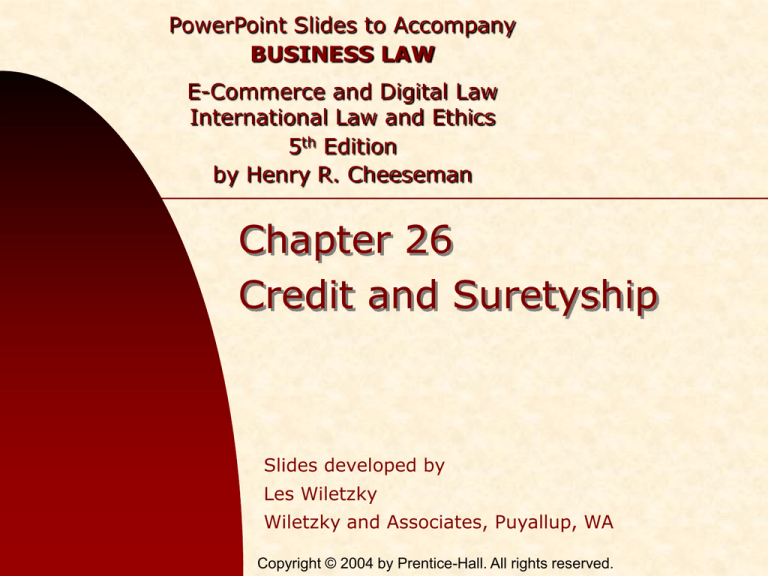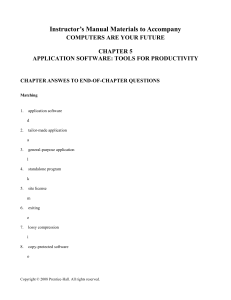
PowerPoint Slides to Accompany
BUSINESS LAW
E-Commerce and Digital Law
International Law and Ethics
5th Edition
by Henry R. Cheeseman
Chapter 26
Credit and Suretyship
Slides developed by
Les Wiletzky
Wiletzky and Associates, Puyallup, WA
Copyright © 2004 by Prentice-Hall. All rights reserved.
Introduction
The United States is a credit economy.
Businesses and individuals use credit to
purchase many goods and services.
Debtor – The borrower in a credit
transaction.
Creditor – The lender in a credit transaction.
Copyright © 2004 by Prentice-Hall. All rights reserved.
26 - 2
Unsecured Credit
Credit that does not require any security
(collateral) to protect the payment of the
debt.
The creditor relies on the debtor’s promise to
repay the principal (plus an interest) when it
is due.
The creditor may bring legal action if the
debtor fails to make the payments.
Copyright © 2004 by Prentice-Hall. All rights reserved.
26 - 3
Secured Credit
Credit that requires security (collateral) that
secures payment of the loan.
Security interests may be taken in real,
personal, intangible, and other property.
The collateral may be repossessed to
recover the outstanding amount if the debtor
fails to make payment.
Copyright © 2004 by Prentice-Hall. All rights reserved.
26 - 4
Security Interests in Personal Property
Personal Property – consists of tangible
property (e.g., automobiles, furniture, and
jewelry) as well as intangible property (e.g.,
securities, patents, and copyrights).
The law provides for various types of security
interests and liens in personal property by
sellers of goods and providers of service.
e.g., Artisan’s and Mechanic’s Lien
Copyright © 2004 by Prentice-Hall. All rights reserved.
26 - 5
Security Interests in Real Property
Mortgages
Notes and Deeds of
Trust
Deficiency Judgment
Right of Redemption
Recording Statutes
Foreclosure
Land Sales
Contracts
Copyright © 2004 by Prentice-Hall. All rights reserved.
26 - 6
Mortgage
A collateral arrangement where a property
owner borrows money from a creditor who
uses a deed as collateral for repayment of
the loan.
Mortgagor – The owner-debtor in a mortgage
transaction.
Mortgagee – The creditor in a mortgage
transaction.
Copyright © 2004 by Prentice-Hall. All rights reserved.
26 - 7
Parties to a Mortgage
Loan of Funds
Owner-Debtor
Mortgagor
(Borrower)
Creditor Mortgagee
(Lender)
Security Interest in
Real Property
Copyright © 2004 by Prentice-Hall. All rights reserved.
26 - 8
Notes and Deeds of Trust
Note – An instrument that evidences the
borrower’s debt to the lender.
Deed of Trust – An instrument that gives the
creditor a security interest in the debtor’s
property that is pledged as collateral.
Copyright © 2004 by Prentice-Hall. All rights reserved.
26 - 9
Parties to a Note and Deed of Trust
Loan of Funds
Creditor
Beneficiary
(Lender)
Owner-Debtor
Trustor
(Borrower)
Security Interest in
Real Property
Legal
Title
If default, can
perfect rights
Trustee
Copyright © 2004 by Prentice-Hall. All rights reserved.
26 - 10
Recording Statute
A statute that requires the mortgage or deed of
trust to be recorded in the county recorder’s
office of the county in which the real property
is located.
This record gives potential lenders or
purchasers of real property the ability to
determine whether there are any existing liens
(mortgages) on the property.
Copyright © 2004 by Prentice-Hall. All rights reserved.
26 - 11
Foreclosure
Legal procedure by which a secured creditor
causes the judicial sale of the secured real
estate to pay a defaulted loan.
All states permit foreclosure sales.
Most states permit foreclosure by power of
sale.
Copyright © 2004 by Prentice-Hall. All rights reserved.
26 - 12
Deficiency Judgment
Some states permit the mortgagee to bring a
separate legal action to recover a deficiency
from the mortgagor.
If the mortgagee is successful,
the court will award a deficiency judgment
entitles the mortgagee to recover the amount
of the judgment from the mortgagor’s property
Copyright © 2004 by Prentice-Hall. All rights reserved.
26 - 13
Right of Redemption
A right that says the mortgagor has the right
to redeem real property after default and
before foreclosure.
Requires the mortgagor to pay the full
amount of the debt incurred by the
mortgagee because of the mortgagor’s
default.
Copyright © 2004 by Prentice-Hall. All rights reserved.
26 - 14
Land Sales Contract
Arrangement where the owner of real property
agrees to sell the property to a purchaser, who
agrees to pay the purchase price to the ownerseller over an agreed-upon period of time.
Often used to sell undeveloped property and
farms.
If the purchaser defaults, the seller may
declare a forfeiture and retake possession of
the property.
Copyright © 2004 by Prentice-Hall. All rights reserved.
26 - 15
Lender Liability
Lenders, in certain circumstances, have
liability exposure in making loans to
borrowers.
A lender is liable to a borrower if the lender
breaches the loan agreement or engages in
fraud.
Liability may also be imposed on lenders by
federal and state statutes.
Copyright © 2004 by Prentice-Hall. All rights reserved.
26 - 16
Material Person’s Lien
A contractor’s and laborer’s lien that makes
the real property to which improvements are
being made become security for the payment
of the services and materials for those
improvements.
Copyright © 2004 by Prentice-Hall. All rights reserved.
26 - 17
Surety Arrangement
An arrangement where a third party promises
to be primarily liable with the borrower for the
payment of the borrower’s debt.
Surety – The third person who agrees to be
liable in a surety arrangement.
Copyright © 2004 by Prentice-Hall. All rights reserved.
26 - 18
Guaranty Arrangement
An arrangement where a third party promises
to be secondarily liable for the payment of
another’s debt.
Guarantor – The third person who agrees to
be liable in a guaranty arrangement.
Copyright © 2004 by Prentice-Hall. All rights reserved.
26 - 19
Summary: Liability of Sureties and Guarantors
Compared
Type of Arrangement Party
Liability
Surety Contract
Surety
Primarily liable.
The surety is a co-debtor who is liable to pay the
debt when it is due.
Guaranty Contract
Guarantor Secondarily liable.
The guarantor is liable to pay the debt if the debtor
defaults and does not pay the debt when it is due.
Copyright © 2004 by Prentice-Hall. All rights reserved.
26 - 20
Collection Remedies
When a debt is past due, the creditor may
bring a legal action against the debtor.
If the creditor is successful, the court will
award a judgment against the debtor.
The judgment will state that the debtor owes
the creditor a specific sum of money:
Principal and interest past due on the debt,
Other costs resulting from the debtor’s default, and
Court costs
Copyright © 2004 by Prentice-Hall. All rights reserved.
26 - 21
Collection Remedies (continued)
The most common collection remedies are:
Attachment
Execution
Garnishment
Copyright © 2004 by Prentice-Hall. All rights reserved.
26 - 22









